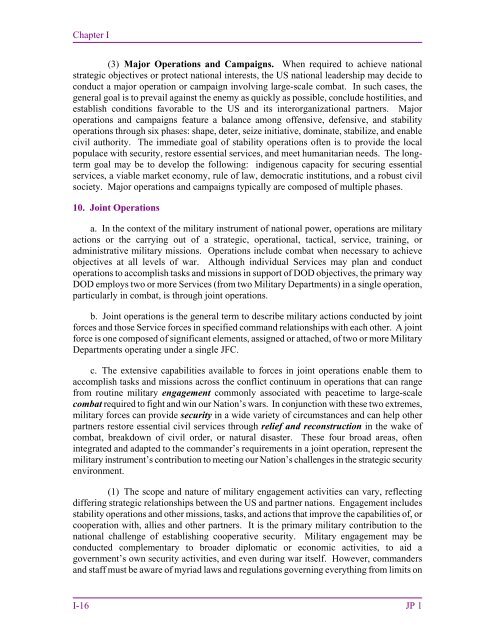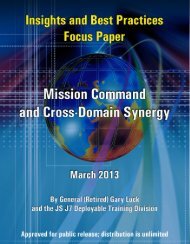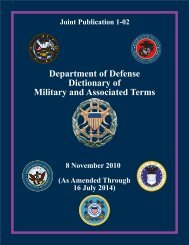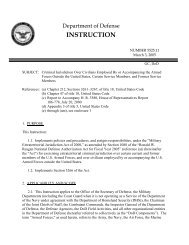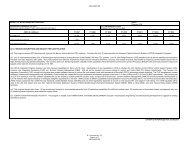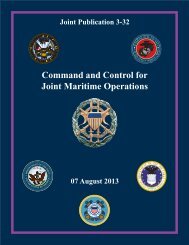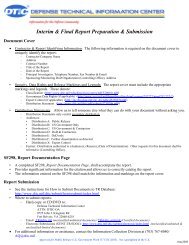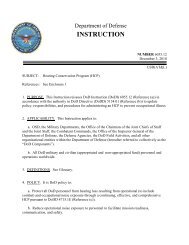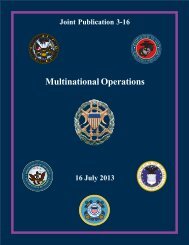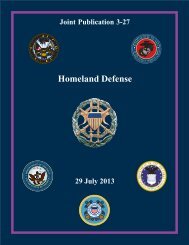JP 1, Doctrine for the Armed Forces of the United States - Defense ...
JP 1, Doctrine for the Armed Forces of the United States - Defense ...
JP 1, Doctrine for the Armed Forces of the United States - Defense ...
You also want an ePaper? Increase the reach of your titles
YUMPU automatically turns print PDFs into web optimized ePapers that Google loves.
Chapter I<br />
(3) Major Operations and Campaigns. When required to achieve national<br />
strategic objectives or protect national interests, <strong>the</strong> US national leadership may decide to<br />
conduct a major operation or campaign involving large-scale combat. In such cases, <strong>the</strong><br />
general goal is to prevail against <strong>the</strong> enemy as quickly as possible, conclude hostilities, and<br />
establish conditions favorable to <strong>the</strong> US and its interorganizational partners. Major<br />
operations and campaigns feature a balance among <strong>of</strong>fensive, defensive, and stability<br />
operations through six phases: shape, deter, seize initiative, dominate, stabilize, and enable<br />
civil authority. The immediate goal <strong>of</strong> stability operations <strong>of</strong>ten is to provide <strong>the</strong> local<br />
populace with security, restore essential services, and meet humanitarian needs. The longterm<br />
goal may be to develop <strong>the</strong> following: indigenous capacity <strong>for</strong> securing essential<br />
services, a viable market economy, rule <strong>of</strong> law, democratic institutions, and a robust civil<br />
society. Major operations and campaigns typically are composed <strong>of</strong> multiple phases.<br />
10. Joint Operations<br />
a. In <strong>the</strong> context <strong>of</strong> <strong>the</strong> military instrument <strong>of</strong> national power, operations are military<br />
actions or <strong>the</strong> carrying out <strong>of</strong> a strategic, operational, tactical, service, training, or<br />
administrative military missions. Operations include combat when necessary to achieve<br />
objectives at all levels <strong>of</strong> war. Although individual Services may plan and conduct<br />
operations to accomplish tasks and missions in support <strong>of</strong> DOD objectives, <strong>the</strong> primary way<br />
DOD employs two or more Services (from two Military Departments) in a single operation,<br />
particularly in combat, is through joint operations.<br />
b. Joint operations is <strong>the</strong> general term to describe military actions conducted by joint<br />
<strong>for</strong>ces and those Service <strong>for</strong>ces in specified command relationships with each o<strong>the</strong>r. A joint<br />
<strong>for</strong>ce is one composed <strong>of</strong> significant elements, assigned or attached, <strong>of</strong> two or more Military<br />
Departments operating under a single JFC.<br />
c. The extensive capabilities available to <strong>for</strong>ces in joint operations enable <strong>the</strong>m to<br />
accomplish tasks and missions across <strong>the</strong> conflict continuum in operations that can range<br />
from routine military engagement commonly associated with peacetime to large-scale<br />
combat required to fight and win our Nation’s wars. In conjunction with <strong>the</strong>se two extremes,<br />
military <strong>for</strong>ces can provide security in a wide variety <strong>of</strong> circumstances and can help o<strong>the</strong>r<br />
partners restore essential civil services through relief and reconstruction in <strong>the</strong> wake <strong>of</strong><br />
combat, breakdown <strong>of</strong> civil order, or natural disaster. These four broad areas, <strong>of</strong>ten<br />
integrated and adapted to <strong>the</strong> commander’s requirements in a joint operation, represent <strong>the</strong><br />
military instrument’s contribution to meeting our Nation’s challenges in <strong>the</strong> strategic security<br />
environment.<br />
(1) The scope and nature <strong>of</strong> military engagement activities can vary, reflecting<br />
differing strategic relationships between <strong>the</strong> US and partner nations. Engagement includes<br />
stability operations and o<strong>the</strong>r missions, tasks, and actions that improve <strong>the</strong> capabilities <strong>of</strong>, or<br />
cooperation with, allies and o<strong>the</strong>r partners. It is <strong>the</strong> primary military contribution to <strong>the</strong><br />
national challenge <strong>of</strong> establishing cooperative security. Military engagement may be<br />
conducted complementary to broader diplomatic or economic activities, to aid a<br />
government’s own security activities, and even during war itself. However, commanders<br />
and staff must be aware <strong>of</strong> myriad laws and regulations governing everything from limits on<br />
I-16 <strong>JP</strong> 1


